I was toward the end of a long endurance ride while eating the delicious malt balls courtesy of The Hut on Tunitas Creek in the San Francisco Bay area. I felt a little undisciplined since I had recently eaten an RX bar and thought I was eating too much, when I began hearing the podcast with Dr. San Millan.
I no longer felt guilty!
It used to be thought that around 60gs/hr was the upper end of absorption, then raised to around 90 g. The Insync testing uses 90g/hr as the top end of absorption and their FatMax graph has 90 gr/h as the top end.
Dr. Inigo Inigo San Millan, in the podcast number 205, brought a interesting perspective.
He noted not enough carb consumption as a problem. He said that for aerobic activities that they were finding that between up to 2.5g/minute
of carbs could be oxidized. That’s up to 150 grams per hour of carbs used in an aerobic ride. 600 calories.
Even in the classic fat-burning zone 1 of 3 aerobic rides where cyclists think that they are burning mostly fat and little carbs, he indicates that the carb expenditures could be up to around 400-500 grams for a ride. Close to 2,000 calories of carbs. And that athletes need to account for that or they could end up with glycogen deficit and start using muscle for fuel. That their stored glycogen stores may not be enough.
He did not say what the max ingestion was, whether he had new information on this, or what he does with his pro athletes, other than on higher energy expenditure days, the nutritionist had them eating more.
I wonder what you insights are on this…and on malt balls.
Other things that caught my attention: other biometrics that could be useful with some athletes is measuring insulin via C-Peptide ( about half of the insulin produced by the pancreas gets used by the liver within a few minutes, so the C-peptide test is more accurate). A lot of Type 2 diabetes and low insulin sensitivity has Liver insulin resistance as a significant factor.
Chronic insulin levels can act as a hormone disruptor, and can contribute to chronically elevated cortisol.
Another useful test is 24-hr salivary cortisol testing to see what the cortisol load and distribution is. Distribution issues may be coming upstream from the brain. Low cortisol load may indicated adrenal stress. Stress first elevates it, and over time for some, the levels start coming down.
This can affect catecholamines, since they are mostly produced in the adrenal medulla. I have seen that Ashwagandha and other adaptogenic herbs can be of help for adrenal function. Ounce for ounce, the greatest amount of Vit C is stored in the adrenals.
One other lab that was not mentioned, likely because of time, are Vitamin D levels. VO2 max, strength,endurance studies on this.
Digestive issues may cause low levels, even if supplements/adequate food is ingested. I’ve seen people on 1K international units a day for a long time still have low levels.
I lived and cycled in Miami and found I had low Vit D levels, so getting sun does not always mean the levels will be sufficient.

